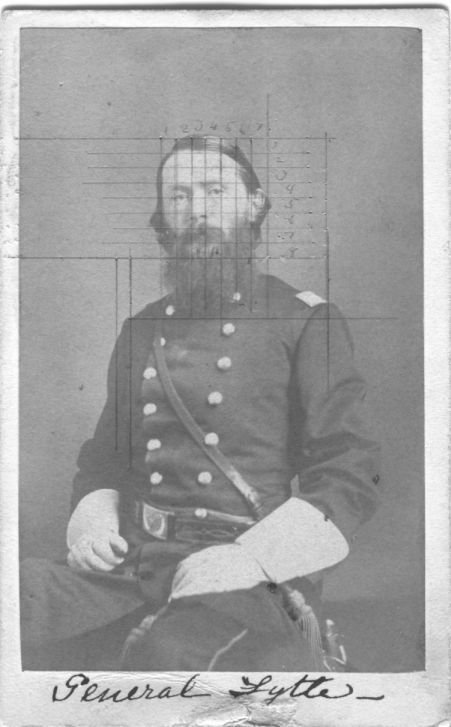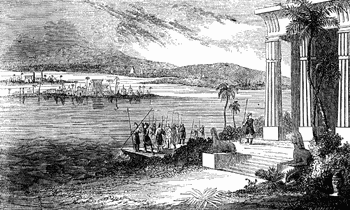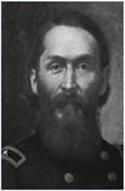|
William Haines Lytle
W. H. Venable, Beginnings of Literary Culture in the Ohio Valley: Historical and Biographical Sketches 284-85 (Cincinnati: Robert Clarke & Co., 1891) [online text]:
Venable provides the following story on the composition of "Anthony and Cleopatra":
William Turner Coggeshall, The Poets and Poetry of the West: With Biographical and Critical Notices 565 (Columbus, Ohio: Follett, Foster and Company, 1860):
Lytle
Park For
Honor Glory and Union: The Mexican and Civil War Letters Poem "Antony and Cleopatra" || "Antony and Cleopatra" Anthologies William Haines Lytle, "Song of the Ragged Attorney," in Ina Russelle Warren (ed.), The Lawyer's Alcove: Poems by the Lawyer, for the Lawyer and about the Lawyer 80-81 (New York: Doubleday, Page & Company, 1900)(Buffalo, New York: William S. Hein & Co., Inc., 1990)(See "Song of the Ragged Attorney," in William H. Venable (ed.), Poems of Wiliam Haines Lytle 128-130 (Cincinnati: Robert Clarke Co., 1894)(This is the only law-related poem to be found in the Venable collection of Lytle poetry) Writings William Haines Lytle, Poems of William Haines Lytle (Cincinnati: Robert Clarke Company, 1894)(William H. Venable ed.) Letters Ruth C. Carter, For Honor, Glory, and Union: The Mexican and Civil War Letters of Brig. Gen. William Haines Lytle (Lexington: University Press of Kentucky, 1999) Research Resources Lytle Family Papers
[Frank Leslie's Illustrated Famous Leaders and Battle Scenes of the Civil War [Used with permission of the Florida Center for Instructional Technology] Frank Leslie, Famous Leaders and Battle Scenes of the Civil War (New York: Mrs. Frank Leslie, 1896): "Battle of Chickamauga, Ga., September 19th-20th, 1863, between Generals Rosecrans and Bragg. Our sketch of this most important battle shows General Thomas and his staff anxiously looking for re-enforcements as his gallant troops from their temporary breastwork of loggs and knapsacks, are repulsing the retreated assaults of the overpowering Confederate forces and saving the whole Army of the Cumberland from destruction. After skirmishing on Thursday and Friday, September 17th and 18th, General Rosecrans on Saturday formed his line, with General Thomas on the left, having under him Brannan, Baird and Reynolds; Negley and Wood held the extreme right at Owen's Ford and Gordon's Mill. Crittenden's corps, consisting of Palmer's and Van Cleve's divisions, formed the centre, with part of McCook's on each side. The line generally followed the Chickamauga, though on the left it took the course of the Lafayette Road. Between ten and eleven A. M. Cranston's brigade, of Brannan's division, met the first attack, and in a few moments the whole division was forced back, Thomas then ordered his entire line to advance, and Longstreet was driven back with slaughter, losing the ground and cannon he had gained, and his corps was fast melting under the blows of Thomas, when Polk and Hill threw their corps with impetuosity on Crittenden, and after a fierce struggle routed him, and drove to the right, in similar disorder, Davis's division, of McCook's corps, leaving a wide gap in the line and exposing Thomas to a heavy flank attack. Back then his victorious troops returned to meet the new enemy, and Thomas, with Negley and Wood, from the right, rallying some of the routed centre, drove the enemy back. Before the deadly fire of this new line the Confederates everywhere retired, and before sunset Rosecrans's army held its old line. During the night Rosecrans fell back to a new line, resting Negley with his right on Missionary Ridge, Van Cleve, Wood and Sheridan on the left, and Thomas more in the centre. The fight commenced on the extreme left, and the Confederates, about ten in the morning, attacked Negley with all their strength, and Longstreet again rolled his verterans on Thomas, and again a bitterly contested fight took place. At last General Reynolds began to give way, and Wood was sent to his relief. As Davis moved to fill Wood's place the Confederates took them in flank, and routing them, severed Rosecrans's line, leaving him, with Sheridan, Davis and Wilder, cut off entirely from the mass of his army. Thomas gathered up the other portion of the army in a strong line on Missionary Ridge, and prepared to resist the last Confederate attack, made with all the inspiration of victory; but his men stood firm, and a cloud of dust to the left soon showed a line advancing on the Lafayette Road. Every eye was strained; a moment would tell whether the day's disaster must close in irreparable ruin or there was yet hope of repulsing the foe. It was General Granger with two fresh brigades, which, fresh for battle, now rushed on the enemy and drove them from a hill which they had gained; and thus aided, Thomas repulsed the enemy, and fell back, unmolested, to Rossville." |



